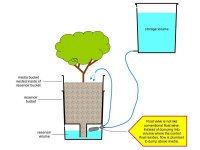cactusjack
Member
Delta - Thought I'd let you know that the little 66 GPH pump (you are right, it really is more of a blower) isn't too big after all. At 17" of head rise I almost exceeded its capability. After feeding through a couple feet of 1/4" drip line and a handful of TEEs and elbows, the little pump delivers only about 9 oz of liquid during a one minute flow. Not too bad and I suspect I can live with that without changing feed frequency or doing any further work on flow restriction. I ended up with a set of TEEs for distribution similar to your approach. My WaterFarm type ring actually didn't do any better at distributing liquid and I think your approach is more predictable/repeatable
Ooooo! I like your idea for a "breathing" media due to pulling liquid out of the reservoir for top feeding. Sounds pretty neat and I guess I will get it for free with my setup. I'll put a piece of electrical tape over the vent hole and tape the joint between the buckets, but at this point its probably gilding the Lilly. This setup is already working so well that the slight benefit might not be noticed. Still, every little bit helps.
Ooooo! I like your idea for a "breathing" media due to pulling liquid out of the reservoir for top feeding. Sounds pretty neat and I guess I will get it for free with my setup. I'll put a piece of electrical tape over the vent hole and tape the joint between the buckets, but at this point its probably gilding the Lilly. This setup is already working so well that the slight benefit might not be noticed. Still, every little bit helps.


 target for imaginary gardner
target for imaginary gardner for re-post...
for re-post...


